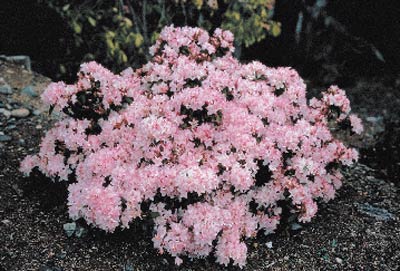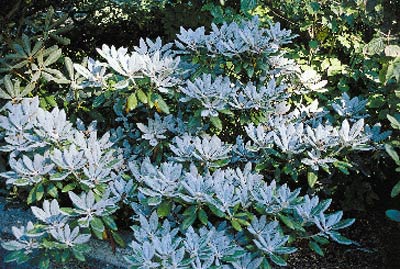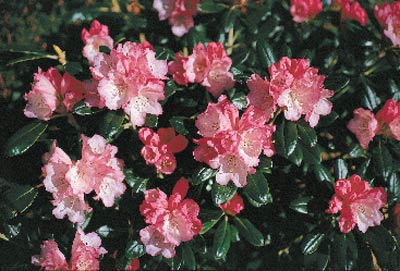Let's Talk Hybridizing: 40 Years and Counting (Playing Bee)
Warren Berg
Port Ludlow, Washington
It seems that most hybridizers are always trying to reach perfection and I am no exception. This is what keeps us going even if we know it's unobtainable. Individual goals vary over time depending on many factors. I like working with species, which gives me more predictable results, and have concentrated on species that are rare, seldom used or are new introductions. In my early days I experimented with species from the Fortunea subsection including
Rhododendron hemsleyanum
and
R. calophytum
. The only problem, however, was the space it took to grow them and also the backbreaking effort in moving these large, fast growing plants.
About this time I was able to get pollen from the Exbury form of
Rhododendron yakushimanum
(now
R. degronianum
ssp.
yakushimanum
), which Fred Robbins had been growing for a few years before it became popular in the United States. This gave me a head start and so I made lots of "yak" crosses with other species and a few hybrids. There were several fine plants out of this group including 'Golfer', 'Jan Bee', 'Berg's Queen Bee', 'Chef Bee'* (recently named), and lots of throw-aways. I was always sorry not to have backcrossed some of these.
As local hybridizing became more popular, the goals seemed to concentrate on the large showy trusses, but I not only wanted to be different, I also wanted smaller, quality plants, preferably crosses that had not been tried before. As luck would have it, I was flying to Japan at the time and became good friends with Koichiro Wada, who kindly gave me pollen and cuttings of his very dwarf
Rhododendron keiskei
. This was the same plant that he, some time earlier, had given to Barry Starling, who named it 'Yaku Fairy'. Being the first to introduce this plant to the Northwest gave me a big head start in my goal for good but smaller plants. This resulted in 'Patty Bee', 'Ginny Gee', 'Golden Princess', 'Wee Bee' ('Not Too Bee'), 'June Bee', 'Peter Bee' and a few thousand not worth mentioning. I sent
keiskei
pollen to Peter Cox who also thought it was a great parent with additions to his Bird series.
My work over the last few years has been mostly with small elepidotes, particularly with
Rhododendron proteoides
,
R. pronum
and other species but also including some fine dwarf hybrids. The goal of course is to develop small plants with excellent indumentumed foliage, good growth habit, special coloring in the flowers and about ten more attributes (dream on). The one exception, that turned out to be very interesting, foliage wise, was a seedling of 'Rosevallon' x 'Rubicon' given to Frank Fujioka which we named 'Whid Bee'.
I have about 1,000 seedlings in different stages with which I hope to do better than my usual one out of a thousand. Even if I am not around to see the results, maybe you will be.
'Berg's Yellow'
*, 1964, is a cross of 'Mrs. Betty Robertson' x 'Fred Rose'. The flowers are bright yellow-green.
'Chef Bee'
*, 1967, is a cross of
R. degronianum
ssp.
yakushimanum
x
R. bureavioides
.
'Ginny Gee'
, 1970, is a cross of
R. keiskei
'Yaku Fairy' x
R. racemosum
(Forrest 19404). The name was registered in 1979 and received the ARS Conditional Award in 1983, the ARS Award of Excellence in 1984 and the ARS Superior Plant Award in 1985. Flowers are light yellow green in bud, opening white with pale purplish pink mottling at lobe margins, both inside and out. Flowers in terminal inflorescence of 9-11 buds (each with 3-5 flowers). A two-tone effect is created with the flowers opening at slightly different times. The flowers completely hide the foliage. The plant forms a tight mat, wider than tall. The foliage is dark and the branches are short and stiff. The plant is drought and heat resistant and does well in an exposed location. It is easy to root and buds up when young.

|
|
'Ginny Gee'
Photo by Warren Berg |
'Golden Bee'
, 1971, is a cross of
R. keiskei
'Yaku Fairy' x
R. mekongense
var.
melinanthum
(now
R. mekongense
var.
mekongense
). The name was registered in 1983, and it received the ARS Conditional Award in 1983 and the ARS Award of Excellence in 1984. The flowers are deep yellow, and the leaves are held two years on this semi-dwarf. It may be semi deciduous in colder climates.
'Golfer'
, 1965, is a cross of
R. degronianum
ssp.
yakushimanum
x
R. pseudochrysanthum
(Exbury). The name was registered in 1983. Indumentum on upper and under sides of leaves for most of year. Flowers are deep purplish pink in bud, opening pale purplish pink with slight brown dorsal spotting; outside striped strong purplish pink.

|
|
'Golfer'
Photo by Warren Berg |
'Honey Bee'
*, 1967, is a cross of
R. hanceanum
Nanum Group x
R. ludlowii
. It has creamy yellow flowers on a compact slow growing bush. New growth is greenish bronze.
'Jefferson Centennial'
*, 1963, is a cross of
R. aberconwayi
x
R. degronianum
ssp.
yakushimanum
.
'June Bee'
, 1969, is a cross of
R. keiskei
'Yaku Fairy' x 'Mary Fleming'. The name was registered in 1995. Flowers are pale yellow green in bud, opening yellowish white; some flowers with a faint narrow longitudinal ribbon of pale purplish pink on outside dorsal lobe. 17-22 flowers in ball truss. Dense habit.
'King Bee'
, 1969, is a cross of
R. degronianum
ssp.
yakushimanum
x
R. tsariense
. The name was registered in 1983. It received the ARS Conditional Award in 1984. Flowers are pink, fading to white with red spotting and deep yellowish pink stripes on a low growing but upright plant with heavy, moderate orange indumentum on leaves.
'Patty Bee'
, 1971, is a cross of
R. keiskei
'Yaku Fairy' x
R. fletcherianum
. The name was registered in 1977. It received the ARS Conditional Award in 1983, the ARS Award of Excellence in 1984, the ARS Superior Plant Award and the German Gold Medal in 1993. It is a compact dwarf with larger foliage inherited from
R. fletcherianum
which turns bronze-red in winter. Flowers are clear pale yellow and unspotted. Trusses have about six flowers.
'Peter Bee'
, 1967, is a cross of
R. hanceanum
Nanum Group x
R. keiskei
'Yaku Fairy'. The name was registered in 2001. Flowers pale greenish yellow in bud, opening light greenish yellow. Five flowers in upright and lax truss with wavy-edged lobes. Dense habit.
'Pretty Bee'*
, 1971, is a cross of
R. ludlowii
x
R. valentinianum
.
'Berg's Queen Bee'
, 1969, is a cross of
R. degronianum
ssp.
yakushimanum
x
R. tsariense
. It received the ARS Conditional Award in 1990, the ARS Award of Excellence in 1991 and the German Gold Medal in 1993. It has a ball-shaped truss of ten pink flowers and is a rounded compact plant with orange-brown indumented leaves that are elliptic and 3 long by 1 wide.

|
|
'Berg's Queen Bee'
Photo by Warren Berg |
'Too Bee'
is a cross of 'Patricia' x
R. keiskei
'Yaku Fairy'. The name was registered in 1983. It received the ARS Conditional Award in 1986, the ARS Award of Excellence in 1989 and the RHS Award of Merit. A dwarf with leaves retained two years, it has three to five flowers, pink from red buds with red spotting in throat, in a lax truss.
'Wanna Bee'
, 1964, is a cross of
R. degronianum
ssp.
yakushimanum
x 'Jiminy Cricket'. It was registered in 1990 by Edna Newcomb. It has ten to twelve flowers of purple-pink in dome-shaped truss. Leaves have a heavy felted indumentum below, yellowish white at first aging to orange-yellow and are held four years. The plant is low and spreading.
'Wee Bee'
(synonym 'Not Too Bee'), 1972, is a cross of 'Patricia' x
R. keiskei
'Yaku Fairy'. The name was registered in 1987. It received the ARS Conditional Award in 1987 and the ARS Award of Excellence in 1989. The flowers, three to five in a lax truss, are vivid red shading to pink in the throat with red spotting. It is somewhat taller growing than 'Too Bee'.
*Name is not registered.
Warren Berg, a member of the Olympic Peninsula, Tacoma and Seattle chapters, is not only a long-time hybridizer but also a plant explorer with numerous trips to Japan, Korea, the Himalayas and China. He has served on the ARS Board of Directors and received the ARS Gold Medal in 1989.